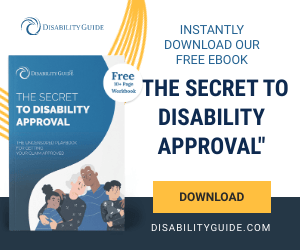About SSI & SSDI
How the Social Security Blue Book of Impairments Can Affect Your Disability Claim

Understanding how the system works can make a world of difference when it comes to getting a Social Security Disability Insurance (SSDI) claim approved. It is a multi-step process that can take several months, and the more armed you are with knowledge, the greater the chances are that your application process will go smoothly and that you will be approved in the shortest amount of time possible.
One of the keys in this process is proving that you have a qualifying disability. If you’re able to do this, you stand a good chance of receiving benefits. Social Security Administration (SSA) processes hundreds of thousands of claims each year, and to help streamline the process, they have created a standardized list of qualifying disabilities that are all listed in the Blue Book of Impairments. When you have a disability that is listed in the Blue Book, you have cleared a major hurdle in gaining approval.
Contents
A little background…how SSDI claims are processed
Social Security offers two programs for those seeking benefits in conjunction with their mental and physical disabilities.
Social Security Disability Insurance is for people who have worked and paid into the system through payroll deductions, and who have developed a disability expected to last one year or more or until they die. Supplemental Security Income helps those who are disabled but do not qualify for Social Security Disability. SSI benefits are based upon need and not whether a person qualifies with an insured status, unlike SSDI.
SSA’s regulations provide a procedure known as the “sequential evaluation process” for disability evaluation. For adults, this is a five-step process that requires sequential review of:
- the claimant’s current work activity
- the severity of his or her impairment,
- a determination of whether his or her impairments meets or medically equals a listing in the Blue Book
- the claimant’s ability to perform past relevant work
- the ability to do other work based on age, education, and work experience.
After a person submits an application for the SSDI benefit, their application is reviewed by a claims rep and a medical examiner. Some applications are denied because a person has too much qualifying income, others are disqualified for a number of other reasons, such as not meeting qualifying medical disability standards. The initial rejection rate is high. About 70% of first time applications are denied for a variety of things.
As part of the review process, SSA officials will look at what kind of disability or multiple disabilities are being claimed. An applicant will need to provide support proof through medical records, doctor’s statements, tests and any other pertinent types of documentation.
Once all of this has been received, a medical examiner will consult the Blue Book of Impairments to see if the applicant’s condition meets one of the qualifying listings. If so, then a large piece of the approval process has been successfully navigated. If your condition is not listed, you can still be approved, but your task will be much more complicated.
What is the Blue Book of Impairments
To determine what qualifies as a disability, Social Security bases many of their decisions on information contained in the Blue Book of Impairments. Most commonly referred to as just the Blue Book, it lists in great detail all the qualifying medical conditions that meet SSA’s test for whether or not a condition is considered a qualifying disability.
While SSA relies heavily on the Blue Book for Social Security disability benefits, there are also other medical conditions that may meet the test for disability that are not included in the Blue Book. An applicant does still have a chance of collecting disability benefits, but they will need to provide additional detailed information about their condition, including medical records, doctor’s statements and any other materials that can be used to make the case to Social Security in getting approved for benefits.
Many of the disabilities listed in the Blue Book are either chronic, permanent and/or fatal. If a person has a disability and it is a listed condition in the Blue Book, it simplifies their application process when they provide the medical documentation needed for approval. However, it does not guarantee that someone will be approved. In fact, despite being listed in the Blue Book, many people with ailments may still be rejected for one reason or another. The absence of a listing-level impairment does not mean a person is not disabled. In these instances, a claims rep will move on to the next step of the process and apply other rules to determine if a disability exists.
The Blue Book is broken into two main parts. Part A is a listing of all conditions that qualify as a disability for Adults. Part B is a listing for all conditions that qualify as a disability for Children. Each part is broken into major categories, such as musculoskeletal system conditions or respiratory system conditions. Within each of these categories, specific ailments are listed in detail to help give a clearly defined set of criteria as to what meets a qualifying condition. When you can prove that you have the symptoms or the condition, this is known as “meeting the listing.” Each listing will often include specific clinical and laboratory tests required to make an evaluation as well.
The medical criteria in Part A may also be applied in evaluating conditions for applicants under 18 if a condition has a similar effect on both adults and children. In some instances, diseases are only found in children or the effects of a disease differs in how it affects children and adults. When evaluating a child under 18, the criteria in Part B will be used first. However, when the medical criteria in Part B do not apply, then criteria in Part A will be used instead.
An impairment may “equal” a Blue Book listing
If an impairment doesn’t match the requirements of a Blue Book listing, the disability claims examiner will determine if a claimant’s impairments can be considered equivalent to a similar listing in terms of severity.
The SSA allows what is known as an “equal” a listing because it can’t include every form or variant of a severe disability in the Blue Book listings. The SSA also recognizes that there are various ways to diagnose and document the same illness. In some cases, a listing may require that a claimant provide results of a very specific test to document their condition. However, if a person did not take that test, but did take another test that shows the same results, it may be considered as equal documentation.
Equal listings may also be allowed in cases where a person has several impairments that by themselves are not severe enough to meet the requirements of a specific listing. However, when these impairments are combined, their severity will equal the requirements of a listed impairment.
If the SSA says your impairments are equally as severe as those in the Blue Book listings, assuming you meet all other requirements, you will be granted SSDI benefits.
Blue Book Part A – Adult Listings
The Blue Book of Impairments undergoes reviews on a regular basis, and impairments are added or deleted as a result. As of early 2018, here is a detailed list of Part A and Part B listings.
Musculoskeletal System
- Disorders of the musculoskeletal system
- Major dysfunction of a joint(s) (due to any cause)
- Reconstructive surgery or surgical arthrodesis of a major weight-bearing joint
- Disorders of the spine
- Amputation (due to any cause)
- Fracture of the femur, tibia, pelvis, or one or more of the tarsal bones
- Fracture of an upper extremity
- Soft tissue injury
Special Senses and Speech
- Loss of central visual acuity
- Contraction of the visual field in the better eye
- Loss of visual efficiency, or visual impairment, in the better eye
- Disturbance of labyrinthine-vestibular function
- Loss of speech
- Hearing loss treated/not treated with cochlear implantation
Respiratory System
- Chronic pulmonary insufficiency
- Asthma
- Cystic fibrosis
- Pneumoconiosis
- Bronchiectasis
- Mycobacterial, mycotic, and other chronic persistent infections of the lung
- Cor pulmonale secondary to chronic pulmonary vascular hypertension
- sleep-related breathing disorders
- lung transplant
Cardiovascular System
- Chronic heart failure
- Ischemic heart disease
- Recurrent arrhythmias
- Symptomatic congenital heart disease
- Heart transplant
- Aneurysm of aorta or major branches
- Chronic venous insufficiency
- Peripheral arterial disease
Digestive System
- Gastrointestinal hemorrhaging from any cause, requiring blood transfusion
- Chronic liver disease
- Inflammatory bowel disease (IBD)
- Short bowel syndrome (SBS)
- Weight loss due to any digestive disorder
- Liver transplantation
Genitourinary Disorders
- Chronic kidney disease
- Nephrotic syndrome
- Complications of chronic kidney disease
Hematological Disorders
- Hemolytic anemias
- Disorders of thrombosis and hemostasis
- Disorders of bone marrow failure
- Hematological disorders treated by bone marrow or stem cell transplantation
- Repeated complications of hematological disorders
Skin Disorders
- Ichthyosis
- Bullous disease
- Chronic infections of the skin or mucous membranes
- Dermatitis
- Hidradenitis suppurativa
- Genetic photosensitivity disorders
- Burns
Endocrine Disorders (including but not limited to)
- Pituitary gland disorders
- Thyroid gland disorders
- Parathyroid gland disorders
- Adrenal gland disorders
- Diabetes mellitus and other pancreatic gland disorders
- Hypoglycemia
Congenital Disorders that Affect Multiple Body Systems
- Non-mosaic Down syndrome
Neurological Disorders
- Epilepsy (convulsive and nonconvulsive)
- Central nervous system vascular accident
- Benign brain tumors
- Parkinsonian syndrome
- Cerebral palsy
- Spinal cord or nerve root lesions, due to any cause
- Multiple sclerosis
- Amyotrophic lateral sclerosis
- Anterior poliomyelitis
- Myasthenia gravis
- Muscular dystrophy
- Peripheral neuropathies
- Subacute combined cord degeneration (pernicious anemia)
- Other degenerative disease
- Cerebral trauma
- Syringomyelia
Mental Disorder
- Organic mental order
- Schizophrenic, paranoid and other psychotic disorders
- Affective disorders
- Intellectual disability
- Anxiety-related disorders
- Somatoform disorders
- Personality disorders
- Substance addiction disorders
- Autistic disorder and other pervasive developmental disorders
Cancer
- Soft tissue cancer of the head and neck
- Skin
- Soft tissue sarcoma
- Lymphoma
- Leukemia
- Multiple myeloma
- Salivary glands
- Thyroid gland
- Breast
- Skeletal system
- Maxilla, orbit, or temporal fossa
- Nervous system
- Lungs
- Pleura or mediastinum
- Esophagus or stomach
- Small intestine
- Large intestine
- Liver or gallbladder
- Pancreas
- Kidneys, adrenal glands, or ureters
- Urinary bladder
- Cancers of the female genital tract
- Prostate gland
- Testicles
- Penis
- Primary site unknown after appropriate search for primary
- Cancer treated by bone marrow or stem cell transplantation
- Malignant melanoma
Immune System Disorders
- Systemic lupus erythematosus
- Systemic vasculitis
- Systemic sclerosis
- Polymyositis and dermatomyositis
- Undifferentiated and mixed connective tissue disease
- Immune deficiency disorders, excluding HIV infection
- Human immunodeficiency virus infection
- Inflammatory arthritis
- Sjögren’s syndrome
Blue Book Part B – Childhood Listings
Low Birth Weight and Failure to Thrive
- Low birth weight in infants from birth to attainment of age 1
- Failure to thrive in children from birth to attainment of age 3
Musculoskeletal System
- Major dysfunction of a joint (due to any cause)
- Reconstructive surgery or surgical arthrodesis of a major weight-bearing joint
- Disorders of the spine
- Amputation (due to any cause)
- Fracture of the femur, tibia, pelvis, or one or more of the tarsal bones
- Fracture of an upper extremity
- Soft tissue injury
Special Senses and Speech
- Loss of central visual acuity
- Contraction of the visual field in the better eye
- Loss of visual efficiency, or visual impairment, in the better eye
- Hearing loss treated/not treated with cochlear implantation
Respiratory System
- Chronic pulmonary insufficiency
- Asthma (in specific cases)
- Cystic fibrosis
- Lung transplant
- Growth failure due to any respiratory disorder
Cardiovascular System
- Chronic heart failure
- Recurrent arrhythmias
- Congenital heart disease
- Heart transplant
- Rheumatic heart disease
Digestive System
- Gastrointestinal hemorrhaging from any cause, requiring blood transfusion
- Chronic liver disease
- Inflammatory bowel disease (IBD)
- Short bowel syndrome (SBS)
- Growth failure due to any digestive disorder
- Liver transplantation
- Need for supplemental daily enteral feeding via a gastrostomy
Genitourinary Disorders
- Chronic kidney disease
- Nephrotic syndrome
- Congenital genitourinary disorder
- Growth failure due to any chronic renal disease
- Complications of chronic kidney disease
Hematological Disorders
- Hemolytic anemias
- Disorders of thrombosis and hemostasis
- Disorders of bone marrow failure
- Hematological disorders treated by bone marrow or stem cell transplantation
Skin Disorders
- Ichthyosis
- Bullous disease
- Chronic infections of the skin or mucous membranes
- Dermatitis
- Hidradenitis suppurativa
- Genetic photosensitivity disorders
- Burns
Endocrine Disorders
- Any type of diabetes mellitus in a child who requires insulin and has not attained age 6
Congenital Disorders that Affect Multiple Body Systems
- Non-mosaic Down Syndrome
- A catastrophic congenital disorder
Neurological
- Major motor seizure disorder
- Nonconvulsive epilepsy
- Benign brain tumors
- Motor dysfunction (due to any neurological disorder)
- Cerebral palsy
- Meningomyelocele
- Communication impairment associated with documented neurological disorder
Mental Disorders
- Organic mental orders
- Schizophrenic, paranoid and other psychotic disorders
- Affective disorders
- Intellectual disability
- Anxiety-related disorders
- Somatoform disorders
- Personality disorders
- Substance addiction disorders
- Autistic disorder and other pervasive developmental disorders
- Cancer
- Malignant solid tumors
- Lymphoma (excluding lymphoblastic lymphoma)
- Leukemia
- Thyroid gland
- Retinoblastoma
- Nervous system
- Neuroblastoma
- Malignant melanoma
Immune System Disorders
- Systemic lupus erythematosus
- Systemic vasculitis
- Systemic sclerosis (scleroderma)
- Polymyositis and dermatomyositis
- Undifferentiated and mixed connective tissue disease
- Immune deficiency disorders, excluding HIV infection
- Human immunodeficiency virus (HIV) infection
- Inflammatory arthritis
- Sjögren’s syndrome
Working with your doctor to get your SSDI claim approved
It is critical to be able to document your medical impairment with as much medical evidence to support your claim as possible. Not only will SSA want to see copious medical records, lab reports, x-rays, medical statements and other related evidence, they will also want to make sure that some of the records are current, meaning that you have been seen by medical professionals within the past 6 months or sooner.
One of the most important documents you can have from your primary treating doctor is a medical source statement. The SSA’s Disability Determination Services will outline what the impairment is and whether or not a claimant can perform tasks such as lifting, sitting, standing and walking, helping to either bolster your support that you cannot work, or providing evidence that you may be able to perform some form of limited work.
As a rule, a treating doctor’s opinions are given the most weight when a disability claim is evaluated. However, in cases where a claimant obtains a medical source statement from a specialist that will be given even more weight when considering a claim.
The key is to not be reluctant when it comes to seeking support from the doctors who are treating you. In some cases, you may also run into a doctor who may not support your claim. When this happens and they are not sympathetic, it might be best to seek out other doctors who agree that your impairment is legitimate, and work with them to develop supporting medical evidence. Also, you must make sure that physical health doctors providing documentation are licensed as MDs, and that all mental health doctors providing documentation are licensed as psychologists or psychiatrists.
If you want more details on how to work closely with your doctor as part of your approval process, check out our article “How Your Doctor Can Help You Get Approved for Social Security Disability.”
What you should know about Compassionate Allowances
One way to shorten the approval time and lessen the burden of documenting medical evidence is by submitting a claim with evidence that a medical condition is so obvious that it easily meets disability standards.
By law, SSA is required to make sure people can receive benefits quickly under this set of circumstances in what are known as Compassionate Allowances. Compassionate Allowances quickly identify diseases and medical conditions that fall under the Blue Book of Impairments with minimal medical information. Allowances include disabilities such as Alzheimer’s disease, some forms of cardiovascular disease, organ transplants, schizophrenia, and others.
The list of Compassionate Allowances has been developed based on public hearing held by Social Security, along with input from medical and scientific experts and the National Institutes of Health.
A full list of Compassionate Allowances can be found here.
What if my condition is not listed in the Blue Book?
The Blue Book is comprehensive and detailed, but there is simply no way that it can contain every possible disease or condition that would qualify as a disability. If a condition is not listed in the Blue Book, do not be discouraged. You have a little more work in front of you, but it is still possible to receive SSDI benefits if you can provide substantial proof that your condition has made it not possible for your to work.
It is common for people who are facing this issue to hire an attorney who specializes in SSDI applications and cases to assist them in preparing documentation and arguments. This is because the amount of additional documentation can be formidable and can include hundreds of pages of complete medical records documenting the disability, testimony and sworn statements from doctors, a detailed and documented work history, and other related documents to help make the strongest case possible.
A disability attorney with several years of experience will have greater insights into what SSA needs and wants to help get an application approved and will be thoroughly familiar with all processes and deadlines along the way. If you are suffering from any kind of advanced and debilitating condition, retaining an attorney can save valuable energy and reduce the amount of stress you may be under when it comes to securing benefits.
A disability attorney will also be able to assist with providing documentation for several possible conditions that when taken separately will not qualify for a disability, but when combined will allow a person to meet the standards set for by the SSA and in the Blue Book.
If your initial claim is rejected, a Social Security disability attorney can also prove to be a valuable asset in an appeal process, correcting any shortcomings from the initial application, bringing in expert witnesses to bolster your case, and working closely with additional medical professionals to document your case on your behalf.
Some conditions that could be construed as a disability are not listed in the Blue Book. These include things such as Lyme disease, thyroid problems, narcolepsy, Fibromyalgia, interstitial cystitis, and others. In situations such as these, rulings are sometimes made that draw in Blue Book listings to help support a claim for one of these unlisted conditions. There are rulings for Chronic Fatigue Syndrome, Fibromyalgia, Interstitial Cystitis and Complex Regional Pain Syndrome.
In situations such as these, developing support and making a case can be highly complex, and is often best served by retaining a Social Security disability attorney to assist in this important process.
Can I appeal a claim?
If you are initially denied on your SSDI claim, then you have the right to appeal the determination. There are actually several levels of appeals that you can pursue.
In most states, the first step is to file a request for reconsideration. Instructions for filing a reconsideration will vary from state to state, but the steps you need to take will be included in your specific initial denial letter. Some states skip the request for reconsideration completely and go directing to the hearing stage. Those states include Alabama, Alaska, parts of California, Colorado, Louisiana, Michigan, Missouri, New Hampshire, New York and Pennsylvania.
Reconsiderations are reviewed by Disability Determination Services and involve a complete review of the initial application. The difference is that the review is conducted by a medical consultant who were not a part of the initial decision. DDS approves benefits in about 10% of all reconsideration appeals. If you are denied again, you may pursue the next level of appeal which is a request for a hearing in front of an administrative law judge (ALJ).
You must request a hearing in front of an ALJ within 60 days of receipt of your reconsideration denial. Appeals must be filed in writing and may be submitted by mail, in person to any Social Security office, or online where available.
ALJs are attorneys who work for the Office of hearings Operations. Most of their work is focused on upholding or overturning decisions to deny or terminate disability benefits. ALJs may request medical expert testimony on complex medical issues. Each hearing office maintains a roster of medical experts who are called to testify as expert witnesses at hearings or to respond to written interrogatories. Hearing offices may also contact medical sources directly. An ALJ may issue a subpoena requiring production of evidence or testimony at a hearing. Your chances for approval are much better at this level, as ALJs approve about 50% of the disability appeal claims that they oversee.
If you lose your appeal in front of an ALJ, you have the right to request that an Appeals Council review your claim. The Appeals Council randomly selects cases to review, and has the power to grant, deny or dismiss a claimant’s request for review. The Appeals Council will look for flaws in the ALJ’s decision before granting a review. Approvals at this level are much less likely. It’s estimated that only about 3% of Appeals Council reviews are granted.
The final step in the appeals process is to file a lawsuit in U.S. district court. A federal judge will hear your case without a jury, and is supposed to review a case only for legal errors. District court judges reverse lower level appeals in a very small number of cases. The good news is that judges remand about half of the disability cases they see for things such as the SSA not considering a doctor’s opinion sufficiently, or that other symptoms or medical proof should have been handled differently.
A few final thoughts…
The Blue Book of Impairments plays a critical role in determining whether or not a person will receive SSDI benefits. Those who have a listed and qualifying disability, and who can provide the necessary medical proof stand a good chance of having their application approved the first time they apply.
However, for those who do not have a qualifying condition, there are other avenues to pursue that can ultimately lead to approval as well. In all cases, the best course of action is to be thorough, take the time to fill out forms as completely as possible, work with your doctors to meet the standards stated in the Blue Book if possible, and understand that the process will take time to produce desired results.
Also, do not rule out the possibility of appealing your initial decision. Appeals are common and with the required additional work that you do to correct any application deficiencies, you could be approved for SSDI benefits.
For more information…
A good place to start with general questions regarding Social Security Disability Insurance is by calling the Social Security Administration at (800) 772-1213. They will be able to answer basic questions and direct you to more targeted resources depending on your needs. If you prefer, you can also visit the SSA website at www.ssa.gov.
If you’re deaf or hard of hearing, you can call the SSA toll- free TTY number at 1-800-325-0778, between 7 a.m. and 7 p.m. on business days
To get a Disability Starter Kit, you can go online here and download a copy that will help you start your claim process.
Social Security offers a series of YouTube videos that will walk applicants through disability claims, including an introduction to the process, filing a disability claim, medical evidence, quality review, appeals, the Appeals Council and the end of a claim.
SSA also has a Disability Planner that can assist and instruct you on how to qualify for benefits, give you tips on getting approved, and more.
About SSI & SSDI
SSDI or SSI: What Makes These Programs Different?

If you are disabled, you can receive help from the government in the form of SSDI or SSI. These two programs help disabled citizens pay for their basic needs. However, the two have different criteria for who to award money to and what you might be eligible for.
SSDI (Social Security Disability Insurance) is an entitlement program that you can access if you have worked before and paid into Social Security retirement benefits. The program allows you to access those benefits early because you have become disabled. SSI (Social Security Income) is for people who are in special financial need and are disabled. Because this program is funded completely by general taxes, there are stringent requirements that one must fulfill in order to receive it.
Here are some of the main differences between SSDI and SSI:
SSDI
- Funded through payroll taxes.
- Available to qualified people who have worked for a certain number of years and contributed to the Social Security trust fund through FICA Social Security taxes.
- Earned after receiving a certain number of “work credits.”
- Eligible for Medicare only after receiving SSDI for two years.
- No maximum asset amount requirements.
- Must be disabled for a five-month waiting period before receiving benefits.
- Spouse and children (over the age of 18) are eligible for partial dependent “auxiliary benefits.”
- Must be younger than 65 to qualify.
SSI
- Funded by general fund taxes.
- Based on financial need.
- Awarded according to low income and low assets—does not deal with work history.
- Can receive Medicaid if eligible for SSI.
- Must have assets less than $2,000 (if single) or $3,000 (if a couple), excluding certain items like primary residence.
- Can receive benefits instantly once approved.
- No dependent benefits.
- Must be blind, disabled, or 65 or older to qualify.
What Do They Have in Common?
SSDI and SSI are both for people who are disabled or blind. However, the eligibility is different when it comes to how old you are. If you are over 65, you can apply for SSI and receive it if your needs match the requirements. SSDI does not cover non-disabled seniors. Those who are not disabled and over the age of 65 are qualified to receive Social Security retirement benefits.
Both programs provide benefits that help take care of your basic needs. Because SSI is a needs-based program, it provides the similar benefit amounts for everyone enrolled. The amount provided by SSI is flexible, meaning you can receive any amount up to the maximum dependent on your need.
On the other hand, SSDI is an entitlement program. Benefits vary according to formulas that the Social Security Administration uses to calculate your specific benefits. The best place to get an estimate of your SSDI benefits is on your Social Security statement. You can see this statement by creating an account on the Social Security Administration’s official website. You can also learn about your Social Security status and other important information at this site.
Even though both the SSI and the SSDI are administered through the Social Security Administration, they have very different application processes. To apply for SSDI, go to the SSA’s online application and follow instructions. SSI is a more difficult process, so we recommend applying at your local Social Security office or on the phone.
About SSI & SSDI
6 Different Types of Service Animals

Did you know that today is National Dog Day? Every August 26, Americans everywhere celebrate the special dogs in their lives. And today we thought we’d celebrate the holiday by talking about service animals.
Animals can help those in need in many ways. A therapy dog is a companion animal that improves mental health by providing assistance to someone with a psychiatric disability, such as post traumatic stress disorder. But these trained dogs can be much more than just a comfort pet.
According to the ADA, a service animal is any animal that provides assistance to a person with a disability. Unlike an emotional support animal for PTSD, service animals also perform tasks to help their owner function normally. This can be anything from supporting them while they walk, retrieving items they drop, or even reminding them to take medication. Traditionally, when we think of a service animal we think of guide dogs for the blind, and for good reason. According to the National Organization on Disability, the vast majority of all services animals are dogs.
1. Miniature horses—This type of service animal has been on the rise in popularity since they’re a great choice for someone with a mobility impairment who needs physical support to walk. Many people who are blind use a miniature horse instead of a guide dog, and there’s actually an entire Guide Horse Foundation for this very purpose. Apparently the miniature horse is really good at its job. The species is naturally cautious, mild-mannered, and sharp-eyed, all of which make for a great assistance animal. And on top of all that, miniature horses can live for up to 30 years. That’s five to seven times longer than your average service dog.But there are actually all kinds of animals that assist people with disabilities. To give you an idea of the variety, here are six animals other than dogs that you probably had no idea could be an awesome service animal:
2. Ferrets—Another unlikely service animal, ferrets have the natural advantages of being easy-going, highly social, and easily transportable. Ferrets make great emotional support animals since they enjoy burrowing close to their owners, which can be extremely comforting to people needing emotional support. But ferrets make great service animals too. These critters are known for alerting their owners when they’re about to experience a seizure, and ferrets can also be trained to wake someone up, remind their owner to take medication, and even interrupt harmful behaviors. Not bad, ferrets.
3. Boa Constrictors—This creature might not be the first animal you’d choose to keep in your home, but they actually make great service animals. These snakes are known for helping patients with bipolar disorder, obsessive compulsive disorder, and panic disorders, and there are even cases when these snakes can be used to prevent medical emergencies. One man in Washington has a friendly boa that will squeeze him more tightly when it senses he’s about to have a seizure, giving him enough time to take his medication or go to a safer location until his seizure passes.
4. Parrots—This is a popular animal for treating psychiatric disorders, namely because many species of parrot have the ability to talk to their owners and deescalate them in stressful situations (something a psychiatric service dog can’t do). A great example of this a man named Jim Eggers from St. Louis who relies on his service parrot, Sadie. The parrot has been trained to repeat the mantra, “It’s OK, Jim. Calm down, Jim. You’re all right, Jim. I’m here, Jim” to calm Jim down whenever she senses he’s about to have a violent episode. Jim used to say the mantra to himself, but now with Sadie’s help he can pre-empt episodes even before they start. Sadie is also trained to alert Jim when someone comes to the door and when he leaves the faucet running.
5. Potbelly pigs—Both highly intelligent and mild-mannered, potbellied pigs can be trained to do all the same functions as the traditional service dog. The only difference is that they’re far cleaner than dogs and also don’t shed as much. Sounds like a good bargain. Plus this particular species is known for being good with kids. Lois Brady from California takes her service pig Buttercup to schools to visit children on the autism spectrum. Since most children don’t have any preconceived ideas about pigs, Brady has found that fewer students are afraid of Buttercup than of a big dog. The pig’s gentle nature also come in handy when he encounters students with aggressive tendencies that would probably make a dog turn around and attack.
6. Capuchin Monkeys—Another very exotic service animal choice is the capuchin monkey. These little helpers are native to South America and weigh about 6 to 10 pounds. Capuchins are especially talented at grasping and retrieving, which makes them invaluable companions for quadriplegics and other disabilities that affect fine motor skills. These monkey can perform nearly any specific task: bringing water, fetching phones, performing basic chores, opening doors, and even feeding someone. There’s an entire organization in Boston called Monkey Helpers that trains little capuchins to be the hands for people who can’t use their own.
Want to read more about service animals? Check out our blog post on how to register a service animal.
About SSI & SSDI
Social Security Updates for July 2015

Like any government institution, Social Security is always changing. If you’re interested in what’s happening in Congress right now, here’s a peek at some current 2015 legislation regarding Social Security:
Ensuring Access to Clinical Trials Act of 2015 (July 16)
This bill allows people receiving Supplemental Security Income (SSI) benefits to participate in clinical trials freely. Because many of these individuals have rare diseases or disabling conditions, they’re often eligible to participate in paid clinical trials. Congress passed a bill in 2009 excluding this compensation from SSI, but the bill was set to expire in October of 2015. The Ensuring Access to Clinical Trials Act of 2015 will effectively remove the expiration date and allow these people to continue participating in clinical trials without the danger of losing their benefits. The bill passed through the Senate with unanimous consent and will now move to the House for further consideration.
Federal Improper Payments Coordination Act of 2015 (July 28)
This bill is designed to grant federal U.S. agencies access to the SSA’s death records through the Do Not Pay (DNP) Initiative in an attempt to prevent and recover improper or duplicate payments. The SSA already shares its death records for research and statistical purposes, but this bill will be improving the sharing and use of the SSA’s data in order to prevent fraud. The bill passed through the Senate with unanimous consent and will now move to the House for further consideration. You can visit the SSA’s website to read more about this bill.
2015 Trustees Report
Every year the Social Security Board of Trustees releases its annual report to Congress. As usual the report showed a surplus of Social Security funds, a nearly $25 billion surplus so far this year. But the board is still projecting that the Social Security Disability Insurance Trust Fund will be depleted in late 2016. Not surprisingly they’re encouraging lawmakers to at least temporarily increase resources to meet the current disability financial needs before 2016. Otherwise disability benefits will need to be cut by 20 percent.
In the past Congress has rebalanced Social Security’s funds to ward off shortfalls, but expansion of the program is another popular option that might occur. Or abolition of the program altogether. How Congress plans to respond remains to be seen, but the Social Security Trustees seem to be in agreement that whatever Congress decides to do, they should do it fast.
Check out the SSA’s website to read the full synopsis of the Trustees Report.
-

 About SSI & SSDI10 years ago
About SSI & SSDI10 years ago6 Different Types of Service Animals
-

 Getting Approved11 years ago
Getting Approved11 years agoWill Medical Marijuana Affect My Social Security Disability Case?
-

 Getting Approved11 years ago
Getting Approved11 years agoQuick Tip: List Your Attorney as a Contact for the SSA
-

 About SSI & SSDI10 years ago
About SSI & SSDI10 years agoSSDI or SSI: What Makes These Programs Different?
-

 Getting Approved10 years ago
Getting Approved10 years ago10 Ways to Keep Your Mind Sharp
-

 News10 years ago
News10 years agoWhy Would You Need to Contact the SSA?
-

 Getting Approved11 years ago
Getting Approved11 years agoCan Social Media Activity Affect My Disability Case?
-

 About SSI & SSDI10 years ago
About SSI & SSDI10 years agoSocial Security and Divorce: 8 Things You Should Know


